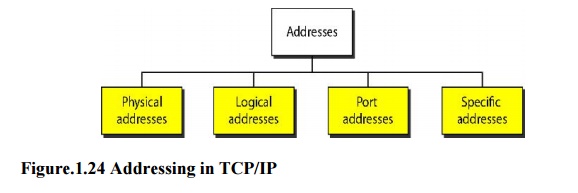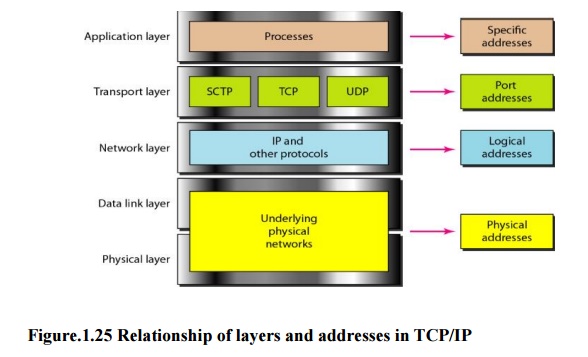Chapter: Computer Networks : Physical Layer
Addressing
ADDRESSING:
Four
levels of addresses are used in an internet employing the TCP/IP protocols:
physical (link) addresses, logical (IP) addresses, port addresses, and specific
addresses.

Each
address is related to a specific layer in the TCP/IP architecture.
a. Physical Addresses:
The
physical address, also known as the link address, is the address of a node as
defined by its LAN or WAN. It is included in the frame used by the data link
layer. It is the lowest-level address.

The
physical addresses have authority over the network (LAN or WAN). The size and
format of these addresses vary depending on the network. For example, Ethernet
uses a 6-byte (48-bit) physical address that is imprinted on the network
interface card (NIC). LocalTalk (Apple), however, has a I-byte dynamic address
that changes each time the station comes up.
b. Logical Addresses
Logical
addresses are necessary for universal communications that are independent of
underlying physical networks. Physical addresses are not adequate in an
internetwork environment where different networks can have different address
formats. A universal addressing system is needed in which each host can be
identified uniquely, regardless of the underlying physical network.
The
logical addresses are designed for this purpose. A logical address in the
Internet is currently a 32-bit address that can uniquely define a host
connected to the Internet.
c. Port Addresses:
The IP
address and the physical address are necessary for a quantity of data to travel
from a source to the destination host. However, arrival at the destination host
is not the final objective of data communications on the Internet. A system
that sends nothing but data from one computer to another is not complete.
Today, computers are devices that can run multiple processes at the same time.
The end objective of Internet communication is a process communicating with
another process. For example, computer A can communicate with computer C by
using TELNET. At the same time, computer A communicates with computer B by
using the File Transfer Protocol (FTP). For these processes to receive data
simultaneously, we need a method to label the different processes. In other
words, they need addresses. In the TCP/IP architecture, the label assigned to a
process is called a port address. A port address in TCP/IP is 16 bits in length.
d. Specific Addresses:
Some
applications have user-friendly addresses that are designed for that specific
address.
Examples
include the e-mail address and the Universal Resource Locator (URL). The first
defines the recipient of an e-mail; the second is used to find a document on
the World Wide Web. These addresses, however, get changed to the corresponding
port and logical addresses by the sending computer.
Related Topics